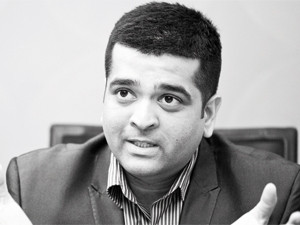
The CIO currently stands at a crossroads of the organisation's technology strategy - to continue investing in legacy (and just how long can this continue?), or gamble on moving to the cloud. It's a high-stakes game, and one that determines the future innovation potential - and ultimate success - of the organisation. So, what are the factors in play? And how do CIOs prepare themselves to move to the cloud?
A major challenge CIOs face, particularly in more established enterprises, is that infrastructure is often inherited, having been built up over time and composed of numerous silos. All of this multiplies the complexity and can make it tricky to get a clear view of what's happening.
Greg Vercellotti, executive director at Dariel, notes the different silos, such as enterprise applications, storage, networks or servers, get optimised over the years, but getting a holistic view of how they're all behaving isn't easy. "As we move forward, the need to respond quicker increases, so we have to do a better job of integrating the costs of those silos, and having a single, end-to-end view," he says.
Bevan Lock, technical sales leader (Enterprise Business Group), Lenovo, agrees. "We need to bridge those silos and get to a single view so we can drive business, and so that IT really becomes an enabler, not an inhibitor, of business."
Michael Langeveld, data centre lead at Microsoft SA, says the number of different vendor solutions that sit in a total infrastructure is partially to blame. "Where we speak to our customer, he probably has, at best, 10 management tools that he's looking at, and never the 10 shall meet."
Lock suggests the different preferences of individual IT technicians play some part in this complex picture. "I think CIOs lost a little control and allowed too much complexity to get involved, based on the whims and desires of various techies. Instead of trying to consolidate, complexity has crept in and now it's expensive. By forcing simplicity and not allowing tool creep, I think they achieve something far more cost-effective than companies with massive toolsets that have to be integrated."
One tool to rule them all

Saurabh Kumar, MD of In2IT Technologies SA, agrees the myriad management tools is an issue, but says it's nothing new and solutions do exist. "In the last four to five years, so many management tools have come in that use data from other tools and consolidate that at one level. That gives the CIO visibility, but also the opportunity to not have five different people managing five different systems."
The ideal of reduced complexity is something that can be further explored with the arrival of converged infrastructure. "Before, a firewall was a firewall, a server was a server, and there was a separate virtualisation tool - all different tools from different vendors," says Kumar. "Now there's one device that handles all of these functions. So, with these converged devices coming in, the CIOs start organising their legacy and begin moving to converged infrastructure because there are fewer people and less technology involved, and fewer vendors to manage. That gives them enough ammunition to start supporting infrastructure better and to improve business alignment."
Another technology development raised by the panellists that could improve infrastructure efficiencies is the software-defined network (SDN) and data centre. Placing physical layers of a network onto a single management platform improves control. "If you're able to manage the physical layer with an OSI model, with a software or application console, it's massively beneficial for an organisation that has multiple layers in several different countries," says Kumar. "But the challenge SDN is facing today is on security, on a single point of failure. Instead of hacking the whole network, an external threat can come into the software-defined network console."
If you look at legacy, the majority of organisations spend more money managing what they've got versus being able to drive new ideas and technologies.
Greg Vercellotti, executive director, Dariel
Lock downplays the impact this will have on penetration of the technology. "I'd argue that we turn back the clock to 10 years ago," he says. "People were using those sorts of arguments about virtual servers. Security is obviously a massive concern around this. But, this thing is going to evolve. We went from physical to virtual servers to get away from the sprawl of hardware, resulting in a massive problem with virtual server sprawl because administrators can now deploy a server by double-clicking it. So it's critical that you wrap the management function in that. Inherently, you have to virtualise all the components. So virtualised severs have come a long way, virtualised storage is happening quickly, and I think virtualised networks will get there as well. In a software-defined data centre, you're looking to have an inventory of what the resources are. And then map that against application needs."

Software-defined networking and infrastructure is an attempt to replicate the benefits that major multinationals are achieving today in the public cloud, says Langefeld. "We know it's near impossible because organisations don't have that kind of cash lying around. What they really need is orchestration, automation and management. They want a private cloud they can manage."
Twist or stick?
The conundrum to the future of infrastructure management is cloud, and developing a strategy around this that suits the needs of the business today and into the future is critical. Getting this right will detail how investments need to be made into the infrastructure going forwards.
Says Dariel's Vercellotti: "If you look at legacy, most organisations spend more money managing what they've got versus being able to drive new ideas and technologies. It requires a change in approach to how you look at it. As you move forward, you have to have a roadmap, and definitely move towards a hybrid cloud-type environment."
Moving to a public or private cloud, if your people, processes and management tools aren't sorted out, it doesn't matter where you move it to, you'll have the same dilemma.
Michael Langefeld, data centre lead, Microsoft SA
Kumar says CIOs often see the decision to stick with legacy or upgrade infrastructure as a purely financial one. "They don't consider the productivity increase; if they start adding that as part of the ROI, it becomes a better business case. We've seen 70% to 75% of our existing customers sticking to legacy infrastructure because that's a devil they know and they have existing people to manage that infrastructure. This isn't the right approach because you have to be flexible and agile enough to adapt to new business challenges," he says.
Taking a gradual, hybrid approach to moving to the cloud seems to be the route to take. Langefeld says: "Many CIOs I speak to buy into the concept around hybrid. In this hybrid world, there are two approaches - the guy who knows he has to transform and acts, and the guy who knows he has to do something but does nothing.

"The CIOs who want to transform start off in this hybrid world. If they have a hardware refresh coming, instead of spending a million, for example, they spend just half a million (on the hardware refresh). The other half million is invested in something new around hybrid and public cloud to get to grips with the value. The challenge is that many of them struggle, as there are very few vendors that can help them around hybrid."
The public cloud, of course, requires no capital expenditure, meaning the halved budget allocation is probably sufficient to rent many times over the same capability that an internal investment would provide. The cloud model with a wider number of providers offers more competitive forces, meaning pricing remains lower. It also means the CIO doesn't need to invest in hard-to-find specialised skills.
Perhaps the most important benefit for infrastructure management of the cloud is the flexibility and future-proofing it offers. IT departments are better able to meet diverse demands from across the business, and quickly too. Kumar outlines the example of a business unit pushing IT to start putting analytics on social media to get feedback on new products launched. At the same time, says Kumar, another business unit wants mobile apps to be developed. For those who keep infrastructure management within the business, this is a major challenge that requires significant investment in hardware, software and skills. By contrast, cloud offers the flexibility to deal with that.
African time
Vercellotti notes there has been some activity by leading local organisations moving 'serious' business applications into their own cloud with public touch points. But the consensus of the panel is that the move to the cloud by South African enterprises has been slow. One factor is the 'wait and see' approach being taken. Recent research by Gartner highlighted failures in private cloud implementations from across the world. Langefeld says these are likely due to a number of complex factors. "Moving to a public or private cloud, if your people, processes and management tools aren't sorted out, it doesn't matter where you move it to, you'll have the same dilemma. Moving to the cloud won't solve those problems; if anything, it will amplify the pain."

Vercellotti adds a lack of regulation around cloud services may have burnt the fingers of some local pioneers. "A lot of companies are engaging with cloud services but are getting very poor experience, so that creates resistance."
Kumar provides another explanation for the slow uptake: "If you look at the infrastructure management cycle over the last 10 years in South Africa, a lot of it has been conducted within enterprise environments through insourcing, where they don't deal with people or processes. With cloud, some of the services go outside the physical environment - hardware, software and infrastructure management are all with different providers and the CIO simply provisions services - so it's a huge mindset change.
"For a lot of our customers, we're taking an 'asset light' infrastructure management approach. Instead of cloud outsourcing, assets remain with the business but infrastructure management is outsourced in piecemeal or in totality to different providers. This allows the CIO to focus on IT processes and manage legacy, cloud and new initiatives coming up and align these with the business. So I see the role of the chief information officer evolving to that of a chief process officer."
Assess the impact
A major reason for slow adoption of cloud is the potential risk; ceding control of applications, data or infrastructure into the cloud is big step to take. "Many architects try to complicate how to assess risk," says Langefeld. "We've simplified it to three tiers: high, medium and low business impact. Low business impact is the first set of applications or technologies to move, as they mitigate risk to the business. That approach can be applied across many elements, such as data sitting on different mobile devices.
"Local CIOs are not risk-averse. They realise the journey to the cloud starts with three things: how to manage mobile devices, data and identities. These are not three separate things, they're one thing. The secret is to keep it simple. The exciting thing about cloud is that if you buy something and you don't use it, you can just switch it off."
I see the role evolving from a chief information officer to a chief process officer.
Saurabh Kumar, MD, In2IT Technologies SA
Vercellotti adds: "I think CIOs are willing to take risks, but don't have the financial muscle to take as much risk as they would like. They're forced to be a little bit more conservative by budget restrictions. The South African CIO can't afford to get it wrong or experiment as much as he'd like to. He goes with what's proven and what he knows."
In spite of the numerous benefits offered, the local cloud movement may take some time to materialise. It's not necessarily the risk that will deter progress, but rather the readiness of local organisations to move their silos and processes to it.
Share